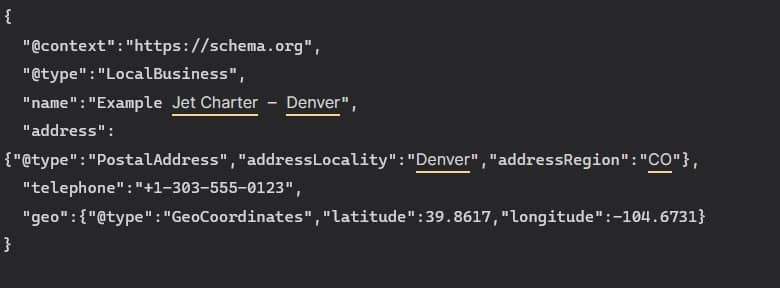table of contents
Free Private Jet SEO Strategies for Effective Online Visibility
This post is written for operators, marketing leads, and local sales teams at private jet charter firms with practical, tactical SEO guidance that drives high-value, locally sourced leads. It explains how local search behavior and maps-first visibility create direct phone and booking opportunities, and it lays out repeatable steps operators can apply without needing deep SEO expertise. This is a free guide for private jet charter companies who want to boost traffic to their site and have the technical expertise to apply the recommendations.
Primary keywords target examples:
- private jet charter Colorado
- private jet charter Denver
- empty leg flights Colorado
- private jet to Aspen
- corporate jet charter Colorado Springs
Use the primary keywords as thematic anchors: place one in the meta title and H1 of pillar pages, distribute variations naturally across H2s and body copy, and reserve exact-match geo modifiers like private jet charter colorado for city or airport landing pages. Avoid keyword stuffing; prioritize clear intent matching and helpful content.
Quick SEO checklist

Why Local SEO Matters for Private Jet Charters
Business dynamics
High-value, local leads. Private jet bookings are high-ticket, time-sensitive transactions that frequently convert offline via phone or direct contact, so visibility in local search directly increases qualified lead volume and lifetime value. Operators and local sales teams that capture searchers with immediate intent see higher close rates and shorter sales cycles.
Seasonality and geo demand. Demand concentrates around regional events, ski seasons, corporate meetings, and vacation windows, which creates predictable local spikes. Tailoring content and landing pages to airport catchments and seasonal routes turns those spikes into repeatable booking opportunities and lets sales teams plan targeted outreach around known demand windows.
Search behavior in 2025
Conversational and location-aware queries. Searches are longer, more natural, and often include location signals such as airport codes, nearby cities, or event names, so content that answers full, conversational queries captures more qualified traffic. Optimizing for voice and long-tail local queries surfaces operators for searchers ready to call or request a quote.
Maps-first visibility. Google Maps and local packs dominate transactional local intent, driving direct actions like click-to-call, directions, and booking clicks. Strong profile completeness, geo-targeted landing pages, and consistent NAP make the difference between appearing in the local pack and losing the lead to a competitor.
On-page Content and Keyword Strategy
Target keyword mapping
Map keywords by intent and page type to avoid overlap and capture the right user goals.
| Keyword | Search intent | Best page type |
|---|---|---|
| private jet SEO | Informational; learn how search drives charters | Blog pillar or guide |
| local SEO for jet charters | Informational with local focus | Blog post or local SEO guide |
| charter flight marketing | Commercial research; marketing tactics | Blog how-to or resources hub |
| private jet charter colorado | Transactional local intent | Service-area landing page |
| charter routes | Informational; route availability | Blog post or route landing |
| empty-leg flights | Transactional/informational | Lead page with real-time inventory |
| on-demand jets | Transactional | Service or booking page |
| executive transfer | Commercial local intent | Local landing page |
| airport codes | Navigational; location-aware queries | FAQ or local landing content |
Local landing pages and site architecture
Create a predictable site structure that surfaces local intent and minimizes keyword cannibalization.
- One service-area page per major metro or airport with unique, locality-specific copy, a local phone number, and localized schema. For example, create dedicated landing pages for key locations such as the front range, front range airport, centennial airport, denver international, range airport, and colorado springs to target local search intent.
- URL pattern should be consistent, for example: example.com/private-jet-charter/colorado-denver.
- Internal linking must flow from national pages to local pages and from the blog to relevant service-area pages using descriptive anchor text.
- Canonical rules must point duplicate or near-duplicate pages to the primary local page to prevent indexation conflicts.
- Folder structure must keep transactional pages separate from the blog to preserve intent signals.
Content types and on-page signals
Different page types carry different signals and conversion roles.
- Authority pages: Fleet pages, operator profiles, and safety credentials that demonstrate experience and compliance and include structured specs and technical details. These should highlight private jet services, private air charter, and air charter offerings, as well as company credentials such as FAA certification, adherence to the highest safety standards, and flights operated by experienced pilots.
- Lead pages: Local landing pages optimized for conversions with click-to-call, booking widget, structured FAQ, and visible trust signals such as recent local reviews. These should reference jet charter flights, private jet charter flights, and charter flights, and highlight features like personalized service, luxurious private jets, available ground transportation, and round-trip pricing.
- Blog assets: How-tos, seasonal route guides, event tie-ins, empty-leg explanations, and case studies that answer long-tail questions and feed internal links to lead pages. Include posts about flying to popular destinations, chartering a plane, understanding cabin size and passenger capacity, and comparing hourly rates and range for different trips.
- On-page signals to surface in each content type include clear H1s, descriptive H2s, schema where relevant, local phone numbers in markup, and visually prominent CTAs. Also include details on access to planes, the range of available aircraft, and how clients can fly to their destination safely, whether for business or leisure trips, both domestically and across the country.
On-page optimization checklist
Apply a concise, repeatable checklist for every page to maximize relevance for local search.
- Meta title that includes the target keyword and geo when appropriate, and stays under 60 characters.
- Meta description that summarizes the page and includes a call-to-action and the primary keyword.
- H1 that matches user intent and contains the primary keyword or a close variation.
- H2s that break the page into scannable sections aligned to user questions and keyword themes.
- FAQ schema for conversational and voice queries with short, direct answers.
- Local schema, such as LocalBusiness, PostalAddress, and GeoCoordinates, on service-area pages.
- Images optimized with descriptive alt text, location-relevant filenames, and modern compressed formats.
- Click-to-call and booking CTA placed above the fold on mobile and present in structured data.
- Internal links from nearby blog posts and category pages to local landing pages using keyword-rich anchor text.
- Canonical tag set correctly to the preferred URL to avoid duplicate content penalties.
- Page speed optimization,s including compressed assets, responsive images, and minimal critical CSS.
- Tracking with event-driven analytics for calls, booking widget interactions, and form submissions.
Technical and Local Setup
Google Business Profile and Maps
Complete, accurate Google Business Profile (GBP) data is often the fastest way to capture immediate, high-intent calls and directions from passengers and brokers. Use an exact NAP, choose a charter-relevant category, add service areas by airport/metro, include a working booking URL, hours, and multiple high-quality photos (interior, exterior, crew, certificates). Post regular updates for empty-leg specials and seasonal routes to keep the profile active and increase GBP impressions.
| GBP field | Why it matters |
|---|---|
| Name / NAP | Matches searcher expectations and prevents ranking friction |
| Primary category | Determines inclusion in relevant local packs |
| Service areas | Targets searches by airport catchment and nearby cities |
| Booking URL | Direct path to conversion; used by GBP actions |
| Photos | Increases trust and click-through from the map pack |
Use GBP features actively: publish Posts for promotions or route alerts, list Services for specific aircraft or transfer packages, add an Appointment/Booking URL for instant reservations, and create Products/Offers for empty-leg or seasonal specials to surface those opportunities in profile actions.
Local schema and structured data
Implement JSON-LD structured data on service-area and lead pages so search engines understand location, services, and transactional options. Prioritize these schema types: LocalBusiness/Service, PostalAddress, GeoCoordinates, FAQ, and Offer. Include accepted payment methods and booking channels to reduce friction for users and clarify intent for crawlers.
Recommended implementation items:
- Add LocalBusiness with precise address, phone, and geo values on each local landing page.
- Add Service entries for charter types (on-demand, empty-leg, executive transfer).
- Use FAQ markup for common local queries (airport pickup times, baggage limits, empty-leg policies).
- Use Offer schema for time-sensitive deals or empty-leg pricing.
Small example snippet (minimal, adapt to site template):
Also enforce technical signals: deliver JSON-LD in the page header, set canonical tags for preferred URLs, add hreflang only if serving other languages, and verify robots.txt and meta-robots rules don’t block local landing pages or important assets.

Also enforce technical signals: deliver JSON-LD in the page header, set canonical tags for preferred URLs, add hreflang only if serving other languages, and verify robots.txt and meta-robots rules don’t block local landing pages or important assets.
Performance and mobile UX
Speed and a frictionless mobile booking flow directly affect conversion for time-sensitive charter customers. Prioritize Core Web Vitals, server-side caching, compressed and responsive images, critical CSS inlined for first paint, and lazy-loading non-critical media.
Mobile UX checklist:
- One-tap call prominently above the fold with a local phone number.
- Minimal booking flow: reduce fields to essentials (date, origin airport code, destination, passenger count, contact).
- Clear CTAs for “Request Quote,” “Call Now,” and “View Empty-Legs.”
- Click-to-book integrations or lightweight booking widgets that open native dialogs rather than full-page redirects.
- Ensure forms degrade gracefully and preserve user input on navigation or refresh.
Test real-device load and booking flows during peak mobile conditions (airports, in-transit) to catch latency issues that kill conversions.
Tracking and crawlability
Set up event-driven measurement and a crawl-friendly site structure so you can attribute calls and bookings to specific local pages and campaigns. Track phone clicks, booking widget interactions, quote submissions, and brochure downloads with GA4 events and tie them to conversion values when possible.
Essentials:
- Configure GA4 events for click-to-call, booking widget opens, and form completions.
- Use Google Search Console for index coverage, URL inspections, and performance queries by city or keyword variants.
- Deploy a clear XML sitemap that includes every service-area page and submit it to Search Console.
- Maintain strong internal linking: link from national pages and relevant blog posts to each local landing page using descriptive anchor text (airport code, city + service).
- Maintain consistent NAP in structured data and visible page content to reduce citation mismatch issues.
Regularly run a crawl audit to ensure local pages are indexable, load quickly, and surface the correct schema; fix orphan local pages by adding contextual internal links from the blog and category pages.
Reputation, Citations, and Partnerships
Reviews strategy
Post-flight follow-ups are the most reliable review source. Send a short, personalized email or SMS within 24–48 hours that includes a direct review link to your Google Business Profile and another to a secondary review site. Use a one-click CTA and a brief script prompt that asks for specifics — route, departure airport, arrival airport, timing, crew, and aircraft type — to increase relevance for local searchers and brokers. Do not offer cash incentives; instead offer operational value-adds such as priority booking windows, complimentary ground transfers, or expedited quotes as a thank-you for detailed feedback. Track review cadence and respond publicly to every review within 72 hours to demonstrate responsiveness and local service quality.
Local citations and listings
Claim and maintain listings where private charter buyers and brokers look first: local airport directories, fixed-base operator (FBO) directories, luxury travel platforms, regional business directories, and charter comparison sites. Centralize NAP (name, address, phone) control in one canonical spreadsheet or CMS module so every citation export pulls from the same source. Audit citations quarterly to correct drift, outdated phone numbers, or inconsistent address formatting. Prioritize listings that show up in local packs and those indexed by maps and travel aggregators.
Partnerships and local link building
Build relationships that create both referral revenue and geographically relevant backlinks. Target high-value partners such as FBOs, concierge services, luxury hotels, event planners, MRO shops, and corporate travel managers. Turn partnerships into linkable assets: co-authored case studies on corporate transfer logistics, guest posts on event pages that list travel partners, sponsored local event pages, and practical resources for brokers that live on partner sites. Use localized sponsorships (airport lounge upgrades, regional charity events) to earn authoritative mentions on municipal and regional domains that strengthen local relevance.
- High-value partner actions: joint promotions with FBOs; concierge referral agreements; co-branded empty-leg alerts with hotels.
- Content partnership tactics: guest article on route demand; co-produced case study showing time savings; partner-hosted landing pages with unique tracking.
Maintain a log of partnership outlets and backlink placements and prioritize outreach to partners whose domains serve the same metro or airport catchment as your service-area pages.
Measurement, Testing, and Scaling
KPIs and attribution
Focus on measurable actions that lead directly to revenue. Primary KPIs are phone calls, qualified leads, booked flights, and ROI per campaign. Supporting KPIs include local impressions, map-pack rankings, GBP actions, and organic landing page conversions. Use unique tracking numbers or dynamic number insertion on service-area pages to route calls back to the originating page or campaign. Record call outcomes in your CRM and import offline conversions into analytics so booked flights can be attributed to the right landing page, organic query, or paid campaign. Assign an average revenue per booked flight and use that value to calculate ROI and prioritize channels that drive net positive bookings.
A/B testing and CRO
Treat service-area pages as conversion experiments, not static brochures. Test one major variable at a time and run experiments long enough to reach statistical confidence on mobile traffic. Prioritize tests that reduce friction for high-intent users: CTA language, phone placement, form length, hero offers, and page templates. Use session recordings and heatmaps to validate assumptions and surface mobile-specific drop-offs. Track micro-conversions such as click-to-call, booking widget interactions, and brochure downloads as leading indicators that predict finished bookings.
Private Jet SEO: Test Items
Scaling playbook
Scale only after you validate a local template with measurable ROI. Build a template-based system for new markets that includes localized copy blocks, schema snippets, local phone provisioning, and a checklist for GBP setup. Operate on a three-part content cadence: a pillar market page, 3–5 cluster posts targeting routes and local events, and seasonal briefs tied to demand cycles like ski season or corporate conference windows. Automate routine updates such as fleet availability and empty-leg feeds through data connectors, but require editorial sign-off on all localized copy, reviews, and credential pages to preserve E-E-A-T. Maintain a central rollout log that records test results, templates used, and campaign ROI so each new market launch improves on the last.
Post-publication and Editorial Plan
Promotion roadmap
Start with immediate, low-friction channels that reach local buyers and brokers. In the short term, publish a concise Google Business Profile post that links to the new local landing page, push a targeted social post to region-specific audiences (airport catchments and charter broker groups), email the corporate contact list with a one-click link to request quotes, and run a small paid local search test to validate high-intent queries. Over the mid-term, move into relationship-driven promotion: outreach to FBO and hotel partners for syndication, submit the piece to luxury travel and local business sites for broader reach, and pursue speaker slots at regional aviation or corporate travel events to position your team as the local expert.
- Short-term: GBP post; targeted social; email to corporate contacts; paid local search test.
- Mid-term: Partner outreach; syndication on luxury and travel sites; regional event speaking.
Maintenance and revision schedule
Treat local content as living assets. Run a quarterly audit that updates seasonal routing info, ties posts to local events (conferences, ski weeks, airshows), reviews performance metrics, refreshes schema and FAQ answers, and replaces any transient offers or empty-leg inventory. Convert strong data-driven posts into downloadable lead magnets and periodically refresh case studies with the latest flight outcomes and revenue metrics to keep proof points current. Maintain a simple editorial calendar that flags seasonal briefs two months before peak demand windows so content and GBP posts align with booking cycles.
- Quarterly tasks: audit seasonal content; refresh schema and FAQs; review ranking and conversion metrics.
- Evergreen tasks: convert high-performing posts into lead magnets; update case studies with current results.
Governance and content rules
Keep blog tone strictly educational and data-led; aim for practical insights that local sales teams can apply the next day. Avoid promotional language and do not reuse reserved transactional keywords tied to service pages. Use this content cluster to target private jet SEO and local modifiers such as city or airport names while routing booking intent to dedicated service-area pages. Enforce a lightweight quality control step: every local landing page or blog update passes an editorial check for factual accuracy, local phone and address consistency, and E-E-A-T signals (crew credentials, safety links, audited reviews).
- Tone: educational, data-led, non-promotional.
- Keyword control: use blog for private jet SEO and local modifiers; keep transactional keywords on service pages.
- Quality checks: factual accuracy; NAP consistency; E-E-A-T verification.
Conclusion
This editorial plan turns local search into a predictable channel for high-value charter leads by combining focused promotion, disciplined measurement, and repeatable content operations. Build template-based local pages, push immediate low-cost promotions to validate demand, and lock in a quarterly maintenance rhythm so seasonal opportunities convert into booked flights. Start with one prioritized market, prove the model with measurable KPIs, and scale the playbook to additional metros once ROI is validated.




